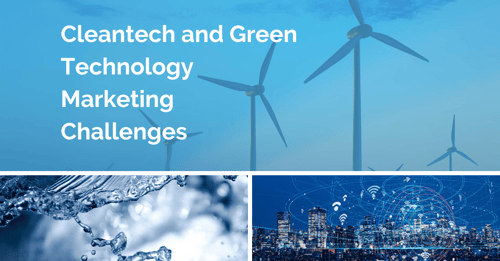 Cleantech, also referred to as clean technology, is often used interchangeably with the term green or greentech. Cleantech is an umbrella term that describes the use of technology and science to create products and services that are environmentally friendly. It is a huge market -- the Green Technology & Sustainability Market is expected to grow from US$ 8.7 billion in 2019 to US$ 28.9 billion by 2024. (Source),
Cleantech, also referred to as clean technology, is often used interchangeably with the term green or greentech. Cleantech is an umbrella term that describes the use of technology and science to create products and services that are environmentally friendly. It is a huge market -- the Green Technology & Sustainability Market is expected to grow from US$ 8.7 billion in 2019 to US$ 28.9 billion by 2024. (Source),
While cleantech solutions are highly innovative, their marketing and sales strategies tend to be old-school. Red Javelin has been working with cleantech companies for years, bringing innovation to the market that conserve water, reduce energy consumption, ensure chemical compliance, and keep renewable energy sources like wind and solar running smoothly.
Cleantech companies are pioneers that are making scientific breakthroughs that will help change our lives and shape our view of the world’s precious resources.
It is easy to get marketing clean and green wrong. It is a balancing act that requires each aspect of the story to be intertwined. The story can’t be too green focused, or too technology focused. It requires balancing business value with innovative technology in the context of sustainable initiatives.
Thought leadership is critical
What happens when you have invented something so different that it doesn’t fit into any existing paradigm? Sometimes, disruption only provides incremental benefits, but on occasion, something new emerges that truly shifts the existing paradigm.
Bringing innovation to the market has its own set of challenges. It takes time and lots of education. In B2B, most firms will stick to what they know and underestimate the effort required to shift a market. Buyers may look at disruptive technology, but it may be too risky to invest in immediately. Buyers need to trust your long-term vision and need to understand the viability of the new technology as well as the hard core business benefits. .
Storytelling plays a huge role in establishing disruptive technology as a market force. A report by Salesforce found that 79% of B2B buyers agree that it's very important or critical for them to communicate with a trusted salesperson or adviser. You need a compelling story and content strategy that drives the conversation across the industry. But a good story is only the beginning. You also need a captivating vision, lots of perseverance, and a strong business value proposition that makes sense.
By positioning your company as the lead expert in your field with relevant and insightful content, your sales staff is set up to provide the advanced consultative sales process that prospective customers want.
 Case Study: Thought Leadership Blog Program Increases Web Traffic by 25% and Increased Share-of-Voice 5X for Cleantech Solution
Case Study: Thought Leadership Blog Program Increases Web Traffic by 25% and Increased Share-of-Voice 5X for Cleantech Solution
Challenge: A business segment within a large global company focused on IoT solutions for smart buildings/smart cities did not have a formalized program for communicating thought leadership and felt that their brand was losing traction against its competitors.
Solution: Red Javelin created a multi-pronged thought leadership program that leveraged their sustainability and technology ecosystems including certifications from LEED (Leadership in Energy and Environmental Design) and Well Building Standard. The team partnered with these organizations for marketing awareness and extended the Company’s visibility into the ecosystems. Red Javelin developed an extensive content marketing plan including a thought leadership blog, premium content, and social media.
Result: Increased web traffic by 25% and leveraged blog content for 18 placements in industry publications for 5X increase in share-of-voice.
Balance your green story with your sales story
Being “green” won’t sell your solution. B2B buyers begin their search for solutions online, and if yours is green, then they are likely to take a second look. If the buyer is well into the buying cycle, your solution may be put on the shortlist for final consideration just because it is green and fits in with corporate sustainability initiatives.
At the core of every buying decision is solving a business problem.
Buyers need to first understand your quantified value proposition and then second understand how your technology plays a role in solving your buyer’s problem. This means your story needs to be layered, touching upon the business value (answers the question why) and technology (answers the question how).
New audiences and stakeholders
Companies that have a corporate goal of reducing carbon footprint or that have corporate sustainability goals have a team in charge of these initiatives. There is someone in the company providing decision guidelines or have the “stamp of approval” for any major purchase that claim green as well as making sure the company is adhering to green practices. One mistake vendors make is not realizing that there is someone new in the buying cycle. For example, you may sell embedded products to design engineers. If that firm has a design green initiative in place, there is someone in the firm, such as a Director or VP of Sustainability, overseeing every design choice, and every vendor selection.
If you are selling technology into the renewables market as opposed to selling the resulting energy to consumers, you also need to take into consideration investors and private equity firms. These organizations invest huge sums of money into renewables infrastructure and have a vested interest in your offerings. They are now influencers in the buying cycle.
 Case Study: Turning Green into Gold
Case Study: Turning Green into Gold
Challenge: Atrion was a provider of product and regulatory compliance solutions for chemical manufacturers. Their primary targeted buying persona held a Director-level compliance title, but they wanted more C-Level engagement within their targeted market. The company wanted to become more strategic within its target market, however, the company’s current message was focused on product features and benefits.
Solution: Red Javelin collaborated with Atrion’s team to define targeted C-level personas. The team extensively researched Atrion’s targeted market’s sustainability, social responsibility and safety programs and crafted a new set of C-level messages around “Corporate Green” which resonated with their target market’s Corporate Social Responsibility (CSR) efforts. We established a leadership commentary and byline program using company experts in green technology and environmental health and safety. Instead of focusing on compliance, the team proactively pitched and secured customer and corporate press coverage on hot environmental topics. Red Javelin also created an extensive content marketing program that included a brochures, whitepapers, and case studies.
Results: PR efforts resulted in regular coverage positioning Atrion as an environmental expert as it related to chemical manufacturing and transportation. The company achieved its business objective and was acquired by IHS – a billion dollar firm.
Proving your green commitment
Just saying your solution is green is almost meaningless if you can’t validate your position in the industry. Green products do not stand alone. Firms need to participate and partner with others in the sustainability ecosystem to move the industry forward. You need to be part of the “club”.
Like networking, green products can’t work alone; they usually require partnerships and integration. Examples include participating in organizations that are driving green initiatives like certification organizations and non-profits focused on conservation initiatives, NGOs, media, and event organizations that offer awards and partnering opportunities, and industry organizations promoting technology standards.
Underinvesting in marketing and sales infrastructure
Firms that don’t invest in a digital strategy will not be competitive. Every B2B buying journey starts with an internet search and without digital visibility, you are at a competitive disadvantage. Your website and SEO practices are only the beginning; you need to have a variety of content assets that tell your story to different audiences at different stages of the buying cycle and a strategy to deliver it to them.
 Case Study: New Digital Infrastructure Boost Inbound Leads at Launch for Wind Farm O&M Solution
Case Study: New Digital Infrastructure Boost Inbound Leads at Launch for Wind Farm O&M Solution
Challenge: Start-up, primarily made up of engineers, was getting ready to launch an O&M solution targeted at Wind Farm owners. The firm’s website consisted mainly of tech speak with very few business benefits. The Company had no marketing tools in place.
Solution: Red Javelin developed a Messaging Blueprint which clearly structured the firm’s value propositions to target a variety of personas in the buying cycle as well as a thought leadership campaign that redefined how wind farms conducted blade inspection. The team also implemented Hubspot and launch an inbound content marketing campaign.
Results: The Company secured significant press coverage, began an aggressive thought leadership campaign using premium content, social media, email marketing, and blogging which generated traffic to the website resulting in 65 marketing qualified leads in the first 90 days post launch.
Cleantech Companies Make a Difference
As consumers become aware of climate change and environmental crises such as water shortages, consumers will ultimately drive businesses to become more environmentally aware.




